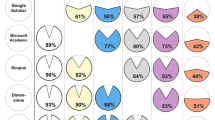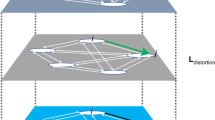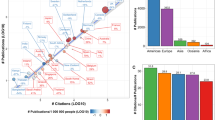Abstract
This paper discusses the publications of Third World Countries (TWC) in theScience Citation Index by disciplines. TWC documents which were nationally cross-linked at least 20 times were identified and their citing documents categorised into seven disciplines. The top 12 TWC are discussed vis-à-vis their population, Gross National Product, and the extent of participation usingobserved rates of contribution in each discipline andexpected rates based on numbers of citations received. Brazil, Mexico, Argentina and Chile, appeared most frequently in the top five ranks in each of the seven disciplines; however, none of these countries had neither the largest population nor the highest GNP per capita. Overall observed rates exceeded expected rates in all but two disciplines: Biomedicine and Agriculture. Physics & Engineering had the highest overall observed rate with the top five TWC exceeding the overall and their individual expected rates. Brazil and Venezuela led by exceeding their expected rates in four of the seven disciplines.
Similar content being viewed by others
References and notes
P. Bourke, L. Butler, B. Biglia,Monitoring Research in the Periphery: Australia and the ISI Indices, Research evaluation and policy project monograph series No. 3. Canberra, Research School of Social Sciences, The Australian National University, 1996, p. 1.
B. Cronin,The Citation Process: The Role and Significance of Citations in Scientific Communication, Oxford: Taylor Graham, 1984, p. 17.
S. Arunachalam, K. Manorama, Are citation-based quantitative techniques adequate for measuring science on the periphery?Scientometrics, 15 (1989) 393–408.
S. Arunachalam, K. Manorama, How do journals on the periphery compare with mainstream scientific journals?Scientometrics, 14 (1988) 83–95.
E. Garfield, Mapping science in the Third World,Science and Public Policy, 10 (1983) No. 3, 112–127.
F. Osareh, C. S. Wilson, Scientific productivity and impact of the Third World Countries (TWC): A citation study. In:Proceedings of the Fifth International Conference of the International Society for Scientometrics and Informetrics. Rosary College. June 7–10, 1995. Medford, NJ., Learned Information, 1995, pp. 403–412.
B. Reeves, C. Borgman. A bibliometric evaluation of core journals in communication research,Human Communication Research, 10 (1983) No. 1, 119–136.
A detailed explanation of the data collection procedures and methodology can be obtained from the following PhD dissertation:F. Osareh,Evaluation and Measurement of Third World Countries' Research Publications: A Citation and Country-by-Country Citation Study. PhD Dissertation. Sydney, NSW, Australia, University of New South Wales, School of Information, Library and Archive Studies, 1996.
Science Citation Index 1985–1989: Five Year Cumulation: an International Interdisciplinary Index to the Literature of Science, Medicine, Agriculture, Technology, and the Behavioral Sciences, Guide and lists of source publications, Philadelphia, ISI Press, 1991, pp. 113–131.
H. Small, E. Garfield, The geography of science: disciplinary and national mapping,Journal of Information Science, 11 (1985) No. 4, 147–159.
Calculations for observed and expected rates are based onSmall & Garfield, 1985, p. 151. See reference in footnote [10] above.H. Small, E. Garfield, The geography of science: disciplinary and national mapping,Journal of Information Science, 11 (1985) No. 4, 147–159.
G. T. Kurian (Ed.)Encyclopedia of the Third World, 4th ed. New York, Facts on File, 3 vols, 1992.
This program was started in the mid-1980s; it was intended to form links between scientists in the European Community (EC) and their colleagues in the Asian, Latin American and Mediterranean (ALAMed) countries. The program provides one-year post-doctoral fellowships to ALAMed scientists to visit an EC laboratory for planning joint research projects; holds workshops to focus and stimulate research; and helps in the submission of fellowships and research project proposals. See Ref. 13 below.
G. Lewison, A. Fawcett-Jones, C. Kessler, Latin American scientific output 1986–91 and international co-authorship patterns,Scientometrics, 27 (1993) 317–336.
Reasons for exclusion of India were articulated in the paper byOsareh & Wilson (1995). See Ref. 6 above.
W. W. Gibbs, Lost science in the Third World,Scientific American, 273 (1995) No. 2, 76–83.
Author information
Authors and Affiliations
Rights and permissions
About this article
Cite this article
Osareh, F., Wilson, C.S. Third World Countries (TWC) research publications by disciplines: A country-by-country citation analysis. Scientometrics 39, 253–266 (1997). https://doi.org/10.1007/BF02458529
Received:
Issue Date:
DOI: https://doi.org/10.1007/BF02458529




